Herbert H. Franklin
| Herbert Henry Franklin | |
|---|---|
| Born |
September 1, 1866 Lisle, New York, United States[1] |
| Died |
July 7, 1956 (aged 89) Syracuse, New York, United States[2] |
| Occupation | Automobile magnate, Business, Industrialist,[3] Newspaper editor[4] |
| Spouse(s) | Never married |
| Parent(s) |
Charles R. Frankin (father) Hannah Bliss Franklin (mother)[5] |
Herbert Henry Franklin (September 1, 1866 – July 7, 1956) was an American automobile magnate, businessman and industrialist, Franklin was born in Lisle, New York located in Broome County in Southern New York State.[6]
In 1886, at age 19, he moved to Coxsackie, New York, where he spent his early career as a newspaper editor for his uncle, who owned a newspaper and publishing company. Franklin remained in that capacity until 1892 when he became interested in "hydrostatic moulding process", or die casting. (Franklin has been credited with coining the term.) Not long after, he quit the newspaper business and relocated to Syracuse, New York.[1]
Franklin founded the H. H. Franklin Manufacturing Company in 1893. The company specialized in machine die casting and made small parts such as gears and bearing caps.[7] It was the first company in the world in that enterprise.[4]
In 1901, Franklin teamed up with engineer John Wilkinson to develop an air-cooled engine and in 1902, the Franklin automobile was born. Because he was the primary investor, Franklin assumed control of the company, and named the auto manufacturing division the Franklin Automobile Company. As president, he managed the company finances and business administration. Wilkinson was named as chief engineer and granted control of the engineering and manufacturing operation.[2]
Franklin died on July 7, 1956 in Syracuse, New York and was buried in Oakwood Cemetery.[2]
Biography
Herbert Franklin grew up on the family farm south of Cortland, New York in Lisle, New York.[2] He was the son of Charles R. Franklin, a dairy farmer[8] and Hannah Bliss Franklin.[5] He had two brothers and three sisters who lived to maturity. His father had been a schoolteacher in Cortland, New York prior to his marriage.[5]
The milk from the family dairy was carried by horse and wagon or sleigh to Center Lisle, about two miles away. Franklin was interviewed later in life and exclaimed; "How I hated to milk cows, My father said the cows gave me short measure when I milked. They were tired from my leaning my head against their sides while I milked. According to father, I wasn't cut out for farm work and he became reconciled to it. So I set out to earn my way elsewhere."[5]
Franklin had a handicap. He had an impediment in speech from a defect with which he was born. "All his life it was necessary for him to be painstaking with speech to be understood.".[9]
Education
Bert Franklin had to walk five miles to the Lisle Academy from his home on the Nanticoke Road. He walked often when his father could not spare a horse for transportation. At the time of his death, in 1956, there were older residents in Lisle who remembered his trek to school. They remembered him as "very quick in learning, an exceptionally bright youngster." [5]
Herbert Franklin graduated from Lisle Academy (1866-1856),[5] however, his formal education never went beyond high school.[6]
Broome County
Several of the young men that Franklin grew up with in Broome County, New York went on to become successful businessmen in Syracuse. This included Alexander T. Brown, Lyman C. Smith, Hurlburt W. Smith and Wilbert Smith who were industrialists in Syracuse.[7] L. C. Smith headed the Smith typewriter business. Alexander T. Brown was credited later with inventing the modern typewriter and he had also invented bicycle gears. The Smith Premier, a double keyboard machine with keys for capital letters and small letters, was made in Syracuse at the Smith Premier Typewriter Company, which was originally located in the old Smith gun plant and later in its own plant on Gifford Street.[9]
Additionally, Giles H. Stilwell, a lawyer and education had attended the Lisle Academy with Franklin. Stilwell was later on the board of directors for the H. H. Franklin Manufacturing Company.[5]
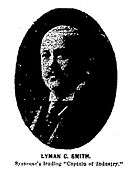 Lyman C. Smith, One of the founders of Smith Premier Typewriter Co., December 31, 1903 |
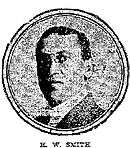 Hurlburt W. Smith, One of the founders of Smith Premier Typewriter Co., July 29, 1904 |
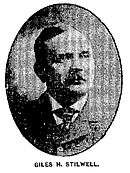 Giles H. Stillwell, Attorney - H. H. Franklin Manufacturing Co., April 27, 1906 |
Sleigh maker
His first job after completing his studies was at a sleigh shop in a neighboring town. According to Franklin "the proprietor paid day wages to the men building sleighs. My job was sandpapering the bodies. It seemed to me that we all took it easy. I talked to the owner about paying by the sleigh, so much for each sleigh I sandpapered. It meant more money for me and more sleighs finished faster for him. Soon the other men in the shop took it up and the whole operation was on piecemeal. I was there for months and he wanted me to stay assisting him in the business, but I didn't think I wanted to be a sleigh-maker either."[5]
Printer's apprentice
He went on to say, "My father wanted me to come home and I went on a visit. There, a cousin of ours, William Franklin, was on a visit at the time. He was on the newspaper at Coxsackie, New York. It had a job shop attached. He suggested my going there with him. I did."[5]
At the age of 19, he moved to Coxsackie, New York on the Hudson River, south of Albany, New York and worked as an apprentice to his uncle, William P. Franklin, owner of the local printing business and publisher of the weekly, The Coxsackie News.[1]
During the first year as apprentice, Franklin, was "paid" room, board and clothes, however, no cash. His work day lasted as long as it took to get the job done. Consequently, he worked many late hours and many times recorded that he worked "day and evening" in the printing office. Within six months of his arrival in the small village, he was promoted to foreman of the printing shop. His ability was such that after only ten months on the job, his Uncle Will considered getting a job in Syracuse and leaving young Franklin in charge of both the newspaper and print shop.[1]
At the end of his first year, Franklin had improved the newspaper and worked so hard he "had replaced a three-year apprentice." After two weeks spent in negotiation with his Uncle, he was offered a yearly salary of $150 plus board and laundry. Although disappointed by the wage, however, he resolved to work "as though I was to get twice as much."[1]
William Franklin acknowledged his nephew's good work in a paragraphed headlined "It Improves," in which he thanked the public for their appreciation of the improvement in The News "which is due to the efforts of our assistant editor, who is full of vim and enterprise and has a wit which tempers his painful truthfulness."[1]
Board of trade
After 18 months work, Franklin was able to organize a local Board of Trade. As secretary, he reviewed local industrial prospects, promoted projects and acted as hiring agent for firms that wanted to relocate to Coxsackie.[4] The first firm lured to the area by the Board of Trade was the Kennedy Valve Company. Soon the plant was drawing new families to the village. Not long after, a shirt factory relocated to Coxsackie from Troy, New York.[4]
Columbia bicycles
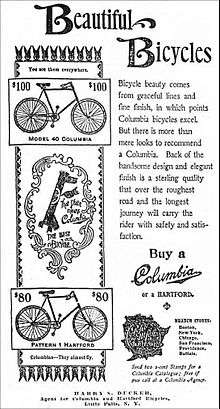
During the late 1890s, the bicycle industry was booming. Herbert Franklin rode his first low "safety" bike and realized many others would be interested in this "new, easy way of getting about." He became an agent for Columbia Bicycle and opened a store in Coxsackie to rent and sell the machines.[4]
Still youthful, Franklin soon organized the Coxsackie Bicycle Club, which performed exhibition riding at the local county fairs.[4]
Real estate and insurance
As a young man, Franklin also owned a real estate and insurance office in Coxsackie, New York with his partner, Frank Bedell.[1] This business was established due to the increased demand for housing after several new factories relocated to Coxsackie.[4]
Franklin was the first real estate agent in the village, however, eventually branched out and sold New York City property and land in Western states.[4]
Not long after, the single telephone line that linked Coxsackie to the Albany, New York switchboard, was placed in Franklin's real estate office. Any messages that needed to be relayed to local residents were delivered personally on a Columbia bicycle.[4]
Other concerns
In 1893, Herbert Franklin had the idea of forming a local building and loan association in Coxsackie. He was a member of the first board of directors.[4]
Deferring to his rural upbringing as the son of a farmer, Franklin was a proponent for the business concerns of the local farmers. He organized a creamery association and was secretary of the Farmer's League, formed in 1890. He was also on the committee that arranged the semi-annual Farmer's Institute, a weekend meeting with out-of-town experts to discuss mutual farming concerns.[4]
Franklin was also the creator, editor and publisher of a monthly called The Common School which circulated among public school teachers in New York State.[4]
Newspaper editor and publisher
While he was running several side businesses, The Coxsackie News went on to become the largest circulation newspaper in Greene County, New York.[4]
A notable gift to the village from the newspaper were weather flags that translated forecasts telegraphed from the U.S. Weather Bureau in Washington, D.C.. "Weather was an important factor in a village that depended on river trade, and in the days before radio and television, the system of flags was a public service that received daily recognition."[4]
In 1892, H. H. Franklin took control of The Coxsackie News after he leased if from William R. Franklin for a year's term with a renewal option for five more years. "I'm here to stay," he said to a fellow editor who felt he might leave someday. This was a prediction that came true not long after, in June, 1893, when Franklin broke his contract and asked his Uncle Will to resume control of the publication.[4]
Franklin publicly announced that because he was unable to buy the newspaper for what he considered a "fair price", he was giving up the business. Franklin quipped; "Life is too short to spend all its best days in building up a business we cannot control."[4]
Franklin left Coxsackie for Syracuse, New York. After his death it was suggested that "whether he was disappointed in love, or whether it was really that he could not buy the newspaper" as his reason for leaving. He was a deeply private man and in later life, few people even knew of his career in the newspaper and printing business.[4]
Along the way, he became a proficient writer, with a gift for producing polished, persuasive ad copy. He also discovered that he had a "flair" for business in general.[6]
Die-cast manufacturer
Herbert Franklin became interested in die casting when Herbert G. Underwood of Yonkers, New York,[10] an employee of a valve company Franklin had helped to bring to Coxsackie, was experimenting with a "hydrostatic moulding process".[4] Franklin was presented with an opportunity to "buy" a patent for the process of die-casting and he jumped at the chance.[6] Later, he accurately predicted, "We are developing a process that will revolutionize the metal manufacturing business."[4]
Die-casting is the process of forcing metal into steel molds so that smooth casting are produced without machining.[11] H. H. Franklin launched commercial die-casting and was considered the "Godfather" of the process. He also pioneered the fabrication of aluminum.[5]
In the early days of the business, Franklin would use steel molds as opposed to the normal sand cast molds used in the process later on.[12]
By 1893, the money he earned from his many enterprises in Coxsackie supported him for almost a year and helped him launch the H. H. Franklin Manufacturing Company in Syracuse which was the first machine die-casting enterprise in the world.[4] The company was incorporated on December 12, 1895.[9]
After several years in business, Underwood grew tired of the day-to-day business and instead wanted to work on perfecting the die-casting process. He sold his interest in the company to Franklin.[9] Later, in 1900, Franklin moved his company to the Lipe Shop, on the northeast corner of West Fayette Street and South Geddes Street (208 South Geddes Street).[13] "This was a famous center for mechanics, engaged in inventing and developing a wide range of devices."[9]
For a time, Howard Franklin, who was Franklin's brother worked for the company. He had set up the first shop which burned down and the company found space in the Lipe Shop.[9]
Franklin found himself in the middle of a business incubator in the Lipe Shop. He formed associations with early business leaders, all in different fields, including; John Wilkinson, Alexander T. Brown, Charles E. Lipe, Albert Seymour, H. Winifield Chapin and James Pass.[13]
Franklin automobiles
Eight years after he established his die-cast business, in 1900, Franklin met a bright, young bicycle racer named John Wilkinson who was a graduate of Cornell University and had already designed two prototype automobiles. Wilkinson earned a degree in mechanical engineering in 1889 and found a job with a local bicycle manufacturer, a "hot" technology of the period. He went on to become a champion cyclist and also developed a keen interest about the inner-workings of internal combustion engines and motor cars.[6]
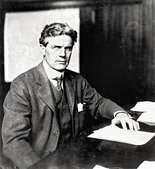
Wilkinson's designs caught the attention of a group of New York businessmen, however, they couldn't decide whether to put his car into production. One member of the group introduced Wilkinson to Franklin, who took a ride in Wilkinson's second prototype. Franklin was impressed and the ride persuaded him to invest $1,100 so that Wilkinson could build a third prototype which went on to become Franklin's first production model.[6]

The Franklin Automobile Company was started and Franklin named the business after himself. He was the president and primary shareholder. He gave Wilkinson stock and appointed him chief engineer. In the early days, Franklin ran the business side and Wilkinson made the engineering and manufacturing decisions. The first Franklin (automobile) Model A was on the market by June 23, 1902 and holds the distinction of being the first four-cylinder automobile produced in the United States.[6]
The new vehicle needed a differential which was soon designed by Franklin's Life Shop business associates; Alexander T. Brown, Charles E. Lipe and H. Winifred Chapin.[13]
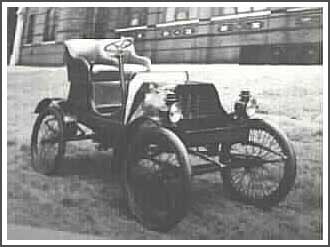
In 1902, Franklin sold a total of 13 cars priced at $1,100 each,[14] and from a modest beginning, went on to become a successful car company. For 28 years, from 1902 to 1930, the company thrived and during much of that time enjoyed the distinction of being the city's largest employer.[6]
Local connections
In April, 1911, Franklin was a member of the floor committee for the party that followed the "fancy dances" arranged for the Children's Charity ball at the Alhambra later that month. Other members of the committee included prominent Syracuse residents such as, Carlton A. Chase (president of the New York State Manufacturer's Association and Syracuse Chilled Plow Company,[15] Donald M. Dey (vice-president of Dey Bros. & Company),[16] Hamilton H. White (founded the Syracuse Bank and the Syracuse Coarse Salt Company), Wilbur Van Duyn (attorney for Central New York S.P.C.A.),[17] Clifford Lipe (mechanical engineer and owner of the Lipe shop)[18] and Wilburt Smith (founder of Smith Premier Typewriter Company).[19] Also included were members of Franklin's firm including George Chapman.[20]
Syracuse club
As a member of The Syracuse Club in 1917, Franklin started a movement to keep New York State highways open in winter for automobile traffic "by removing snow at points where drifts occur."[21]
Franklin pointed out "With so much money represented by the ownership of automobiles and by the construction and maintenance of State highways, it does not seem right that these roads should be closed to a large volume of traffic for several months a year on account of snow."[21]
According to Franklin and others who believed that the snow problems must be solved as "a matter of public economy and convenience, the annual expense will not be as great as it would seem at first thought." He pointed out that it would only be necessary, "except when exceptionally heavy snowfalls occur, to tunnel though occasional drifts."[21]
At that time, some of the Northern New York counties had funds appropriated especially for keeping roads open for sleighs for which the State also contributed. Franklin suggested a new technology, "the snow roller as one of the devices adopted in recent years in this Winter work of making roads passable."[21]
Bankruptcy
In 1930 Franklin Automobile Company introduced a new type of engine which ultimately produced 100 horsepower (75 kW), with one of the highest power-to-weight ratios of the time. In 1932, in response to competition amongst luxury car makers, Franklin brought out a twelve-cylinder engine.[22] Air-cooled with 398 cubic inches (6.5 L) it developed 150 hp (110 kW). The V-12 was designed to be installed in a lightweight chassis, but the car became a 6,000 pound behemoth when Franklin engineers were overruled by management sent in from banks to recover bad loans. Although attractive, the V-12 did not have the ride and handling characteristics of its forebears. Unfortunately, this was simply the wrong vehicle to be building after the crash of 1929 and the Great Depression that followed. The cars sold poorly, only 200 were ever produced,[6] and came nowhere near to recouping the company's investment.
Like other makers of high-priced cars, Franklin Automobile Company was badly hit by the Great Depression. Production in 1932 was only 1,898 units and in 1931, a mere 1,100 units, down from a high of 14,000 units in 1929.[14] In addition, an agent from the bank stepped in and took control of the company and made many bad business decisions that caused Franklin to slip even further.
H. H. Franklin Manufacturing Company and Franklin Automobile Company were both declared bankrupt on April 3, 1934 after reporting $2,088,000 in bank loans long overdue. For three years Franklin had "doggedly" fought off failure. He had "cajoled" his bankers into renewing bank loans that were equal to three times the company's current assets. Despite all hopes, reorganization plans fell through and the company passed into bankruptcy and the hands of a receiver.[14]
Later life
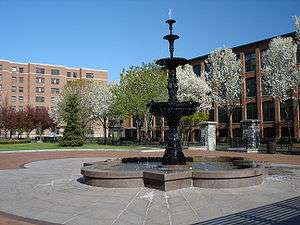
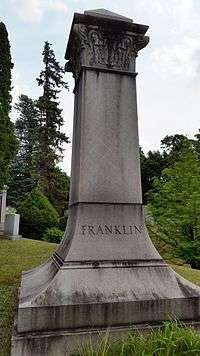
By April, 1953, Franklin was retired and had just returned from his 13th trip to Italy and France. He was almost 87 years old and "still active in mind and body." He expressed that he believed it would be his last visit to Europe. It was his practice to make annual trips to visit his sister, Mrs. Caroline Moser, a widow, at her home in San Remo on the Mediterranean. After she died in 1943, Franklin did not receive word of his sister's death for more than a year due to World War II.[23]
He was a bachelor and had always shunned personal publicity, although he never lost an opportunity to publicize the merits of the Franklin car. "He kept all his eggs in one basket, so to speak. He refused to invest his money in anything but Franklin company." His only other interest during his Franklin years was playing golf. After the company closed down, Franklin retired and lived quietly at his home at the Hamilton White homestead at 1013 James Street in Syracuse. He devoted much of his time to two new hobbies, photography and painting in oils.[23]
H. H. Franklin died in 1956 in Syracuse at age 89. He was buried in Oakwood Cemetery. He never married.[1]
Memorials
Herbert Franklin was inducted posthumously to the Automotive Hall of Fame in Dearborn, Michigan in 1972.[24]
Franklin Square, on the city's lower Westside, a former industrial neighborhood in Syracuse was named for the H. H. Franklin Manufacturing Company. The former Franklin plant was converted into apartments and office space in 1987.
References
- 1 2 3 4 5 6 7 8 Rivette, Barbara S. (August 17, 1988). "Launching a Big Business". Chittenango-Bridgeport Times. Chittenango, New York.
- 1 2 3 4 "Herbert H. Franklin". Find a Grave, New York. N.Y., 2010. Retrieved 2010-07-16.
- ↑ "History of the Franklin Company". Baldwinsville Messenger. Baldwinsville, New York. January 2003.
- 1 2 3 4 5 6 7 8 9 10 11 12 13 14 15 16 17 18 19 20 "From 'Main St.' - The H. H. Franklin Story, pg.17". Marcellus Weekly. Marcellus, New York. August 17, 1988.
- 1 2 3 4 5 6 7 8 9 10 "A Man and an Automobile - The Story of Herbert Franklin". Syracuse Herald-Journal. Syracuse, New York. April 19, 1956.
- 1 2 3 4 5 6 7 8 9 "1932-1934 Franklin V-12". HowStuffWorks, Inc., 2008-2010. Retrieved 2010-07-17.
- 1 2 Automotive Industries, Volume 26. The Automobile Weekly, The Class Journal Company, New York. N.Y., June, 1912. Retrieved 2010-07-18.
- ↑ "Lisle". The Evening Herald. Syracuse, New York. August 10, 1897.
- 1 2 3 4 5 6 Early, Frank J. "The Story of Herbert H. Franklin". The H. H. Franklin Club, Inc., Syracuse, N.Y., from Air Cooled News - Issue No. 10, July 1956.
- ↑ "Claims Infringement on its Patents". Syracuse Post-Standard. Syracuse, New York. October 26, 1902.
- ↑ "Pioneer of Air-Cooled Auto, Franklin Still Boosts Idea". Capital Times. Madison, Wisconsin. July 26, 1931.
- ↑ "Inventions Built Industries Here". Syracuse Journal. Syracuse, New York. March 20, 1939.
- 1 2 3 "Syracuse to Share Auto Prosperity". Syracuse Herald. Syracuse, New York. January 13, 1928.
- 1 2 3 "Business & Finance: Franklin Under". Time Inc., April 16, 1934. April 16, 1934. Retrieved 2010-07-17.
- ↑ "Call Compensation Rider a Menace". New York Times. New York, New York. February 12, 1915.
- ↑ "Club men in caricature". Internet Archive, Cornell University Library, 2010. Retrieved 2010-08-11.
- ↑ "Humane Advocate". The Illinois Humane Society, November, 1913. Retrieved 2010-08-11.
- ↑ "Journal of the American Society of Mechanical Engineers". The American Society of Mechanical Engineers, December, 1917. Retrieved 2010-08-11.
- ↑ "Typing in Tompkins". The History Center in Tompkins County, 2010. Retrieved 2010-08-11.
- ↑ "Floor Committee for Charity Dance". Syracuse Herald. Syracuse, New York. April 13, 1911.
- 1 2 3 4 "Wants to Keep State Highways Open in Winter". Binghamton Press. Binghamton, New York. January 13, 1917.
- ↑ Ludvigsen, Karl (2005). The V12 Engine. Haynes Publishing. pp. 110–113. ISBN 1-84425-004-0.
- 1 2 Bell, J. Burr (April 14, 1953). "Herbert Franklin Back After 13th Trip to Europe". The Post-Standard. Syracuse, New York.
- ↑ "Inductees". Automotive Hall of Fame, Dearborn, Michigan, 2010. Retrieved 2010-08-01.